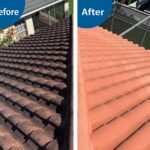Meyers Roofing Company – Understanding Roof Leak Repairs: Common Causes and Solutions

Roof leak repairs are a homeowners’ worst nightmare. Not only are they a structural risk to the home itself, but they can also destroy your wallet later on if repairs are needed due to lack of attention. Not all roof leaks happen due to general wear and tear; Types of roof leaks often start near specific and vital areas of the roof, including chimney, skylight, valley, and flashing. Where leaks tend to occur can give homeowners an idea of what do look out for and when to call in the pros.
Roof Leak Repairs Common Causes and Solutions
Here’s a rundown of the most common leak-prone areas and why they need attention.
Chimney Leaks:
Chimneys are often the source of a roof leak. But, as they bring character and warmth to a home, they are also creating gaps and vulnerable spots where water can get in Common issues around chimneys include damaged flashing or gaps between chimney and roofing materials.

Why It Happens:
Over time, the flashing around a chimney (the material which seals the joint between the chimney and the roof) wears out is exposed to the elements (the weather), which causes it to crack, and subsequently leak. Also, water can enter through small cracks because mortar and bricks can wear off.
Repair Solution:
For chimney leaks, a roofer might need to fix or replace the flashing, seal gaps or even apply a waterproof coating to the bricks and mortar to deter future leaking.
Skylight Leaks
Skylights let natural light into a home, but because they interfere with the roof’s surface, they are prone to leaks if the seals wear out or the installation is faulty.
Why It Happens:
Skylights have seals that join them to the roof, to stop water firming. Over time, these seals can deteriorate or wear down, allowing water to seep through. In addition, the durability of skylights is also related to the slope of the roof and the direction of water flow.
Repair Solution:
Sealing the edges or replacing the flashing around a skylight is a common solution to stop a skylight leak. Routine inspections are important to identify early indications of deterioration and to prevent problems from developing further.

Valley Leaks
Roof valleys are those areas where two slopes meet and creating a natural water runoff path. While valleys are critical for channeling water off the top of a home, they can also be subjected to leaking when damaged or clogged with debris.
Why It Happens:
Valleys typically receive greater water runoff exposure than other roof regions. When the shingles or flashing in this area becomes damaged or deteriorates, water accumulates and leaks. The added weight from the buildup can also push water back, putting pressure on the valley’s structure.
Repair Solution:
Repairing valley leaks often requires replacing damaged shingles, removing debris, and replacing the area with new flashing. This area needs to be frequently checked to identify before they become a problem.
Flashing Leaks
“Flashing is one of the most important components in a roofing system because it seals joints and prevents water from getting into vulnerable areas. Flashing is commonly installed around chimneys, vents, skylights, and roof edges. But, the flashing materials can deteriorate and leaks, if ignored, can become an issue.
Why It Happens:
Flashing is usually made of materials like aluminum or steel, which are strong but known to rust or separate with the elements, exposure and age. Warm and cold weather, which allows contraction and expansion of the flashing, create gaps for water to penetrate.
Repair Solution:
Flashing Rusted proper flashing only needs to be removed and replaced or replaced that covers the openings of the roof that are sealed tight. Frequent inspection of and tightening flashing around vulnerable locations can save you in the future from expensive water damage.

Roof Leak Repairs Tips for Homeowners
Although certain areas are more prone to leaks, homeowners do have preventative steps they can take to help protect their roofs:
Regular Inspections:
That means some level of wear and tear happens every year, which is why scheduling annual or bi-annual roof inspections are important to catch t before they snowball into major issues.
Remove Dirt in Gutters and Roof Valleys:
Cleaning debris from gutters and valleys regularly can avoid water backup and reduces pressure applied on the roof.
Check Flashing and Sealants:
Sils should be examined regularly, particularly in weak spots such as chimneys, skylights and valleys. If you find an area with peeling or cracking, it might be time to get a professional inspection.
Trim Overhanging Branches:
Branches close to the roof can rub against the shingles and be damaging. Overhanging branches also shed leaves and debris on to the roof that can clog valleys and gutters.
Meyers Roofing Company – FAQ (How to Fix a Roof Leak?)
What causes roof leaks?
Common causes of roof leaks are damaged shingles, clogged gutters, faulty flashing, or the general wear and tear of an aging roof. If these problems are left unaddressed, it can result in significant damage within your home.
How can I know if I have a roof leak?
Check for water stains on ceilings and dripping or wet spots that may signify a leak. [Read: If You See These Signs in Your Home, Don’t Ignore Them.]Ignoring these signs can lead to bigger problems later on, like mold and structural damage.
Why is it important to repair a roof leak as soon as possible?
Putting off repairs can cause serious damage — to your home and your bank account. If not treated, a small leak can can cost a lot of money and be a dangerous problem.
Can I repair the leak myself?
Although you might be tempted to do some DIY repairs, it’s better to enlist a professional. We know how to make it right, so you don’t have to worry about temporary fixes.
Are Roof Leak Repairs Covered By Insurance?
It’s also worth asking your insurance provider — roof repairs are often covered if the damage was caused by a storm or other insured events.













